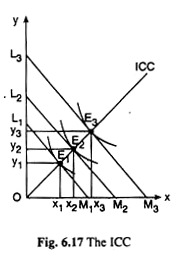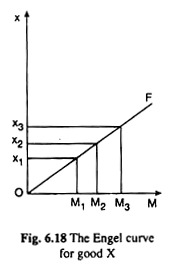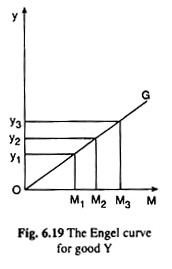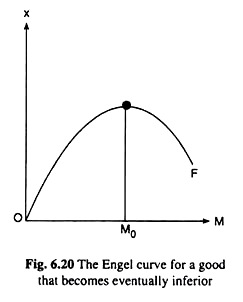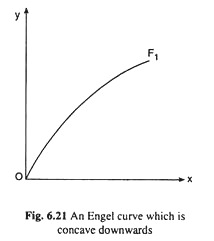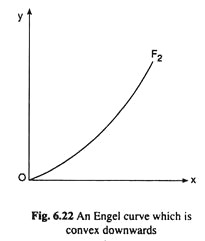In this article we will discuss about the Engel curve for individual and group of consumers.
The Engel curve, named after the German statistician Ernst Engel (1821-96), is a relation between the demand for a good and the income of its buyers, the former depending on the latter.
The Engel curve of an individual consumer can be obtained from his ICC. As, every point on the ICC for an individual consumer like the curve given in Fig. 6.17, is a combination of three items—his money income (M), his demand for good X and that for good Y.
For example, the point E1 is a combination of money income, L1M1 i.e., the money income represented by the budget line L1M1, demand for good X = x1 and the demand for good Y = y1, i.e., the point E1 is a combination (L1M1, x1, y1). Similarly, the point E2 is a combination of (L2M2, x2, y2), and so on.
ADVERTISEMENTS:
Therefore, the points on the ICC in Fig. 6.17 gives a set of combinations of money income and demand for X like (L1M1, x1), (L2M2, x2), etc. and another set of combinations of money income and the demand for good Y like (L1M1, y1), (L2M2, y2), etc.
The first set of combinations, if plotted explicitly in a diagram would give the consumer’s Engel curve for good X like the one given in Fig. 6.18, and the second set of combinations would give us his Engel curve for good y—this is given in Fig. 6.19.
ADVERTISEMENTS:
Since the ICC in Fig. 6.17 is sloping upward towards right throughout its length, the consumer purchases more of both the goods as his money income increases, prices remaining the same.
That is why both his Engel curves, OF and OG, for good X and good Y, respectively, have been upward sloping in Figs. 6.18 and 6.19. For the sake of simplicity, these curves have been shown as straight lines. On the other hand, if X or Y becomes an inferior good x to the consumer as his income rises beyond a certain level, the ICC would be bending to the y-or to the x-axis respectively.
Consequently, the Engel curve for an inferior good (X or Y) would be bending to the horizontal axis, provided measures the quantity of the good along vertical axis, because after a certain level, as income rises, the consumer reduces the purchase of the good. This sort of an Engel curve has been shown in Fig. 6.20.
According to Engel, for some goods, the consumer’s expenditure rises proportionately with his income. His Engel curve for such a good (say, X) would be an upward sloping straight line from the origin like the curve OF shown in Fig. 6.18.
It may be noted here that if the consumer increases the purchase of both the goods, X and Y, proportionately, as his money income rises, prices remaining constant, then his ICC also would be an upward sloping straight line from the origin like the curve shown in Fig. 6.17.
On the other hand, there are some goods (e.g., food) the consumer’s purchase of which increases less than proportionately as his money income rises. For such a good, his Engel curve would be upward sloping and concave downwards like the curve shown in Fig. 6.21.
Lastly, the consumer increases the demand for some goods (luxury items) more than proportionately as his money income rises. The Engel curve for such a good will be upward sloping and convex downwards like the curve given in Fig. 6.22.
The Engel Curve for a Group of Consumers:
The Engel curve for an individual consumer. However, the curve can also be obtained for a group of consumers. If there are no external effects in consumption, the Engel curve for a group of consumers for any particular good may be obtained as a summation (horizontal or vertical, as the case may be) of the individual curves.
However, for any income or income class, the physical quantity demanded by the households of the group may be converted into the total expenditure on the good and divide this total by the number of households, the average expenditure of a family is obtained belonging to a particular income class.
ADVERTISEMENTS:
Now plot the average family expenditure against the different income values and by joining the points, the Group’s Engel curve for the good is obtained. This curve would give the expenditure on the good of an average family belonging to a particular income-class. This curve would also give how the average expenditure on the good would change as the money income of the consumers increases.
It may be noted that if prices remain constant, the percentage change in expenditure on the good would be the same as the percentage change in the quantity physically demanded of the commodity.
According to Engel, for a “necessary” good like food, the expenditure of an average family would increase less than proportionately as its money income rises. So the Engel curve for a “necessary” item would be upward sloping and concave downwards, if expenditure on the good is measured vertically and income horizontally.
On the other hand, for a “luxury” item, the expenditure of an average family would increase more than proportionately as its money income rises. The Engel curve for such an item would be upward sloping and convex downwards. Lastly, according to Engel, there are some items for which the expenditure of an average family would increase proportionately with rises in money income.
ADVERTISEMENTS:
In this case, the Engel curve would be an upward sloping straight line from the origin. Lastly, if the commodity concerned is an inferior good, then the Engel curve for the group, like the individual curve, would eventually bend towards the income-axis. Therefore, the Engel curve for a group of consumers would assume the same types of shape as the individual curve.
